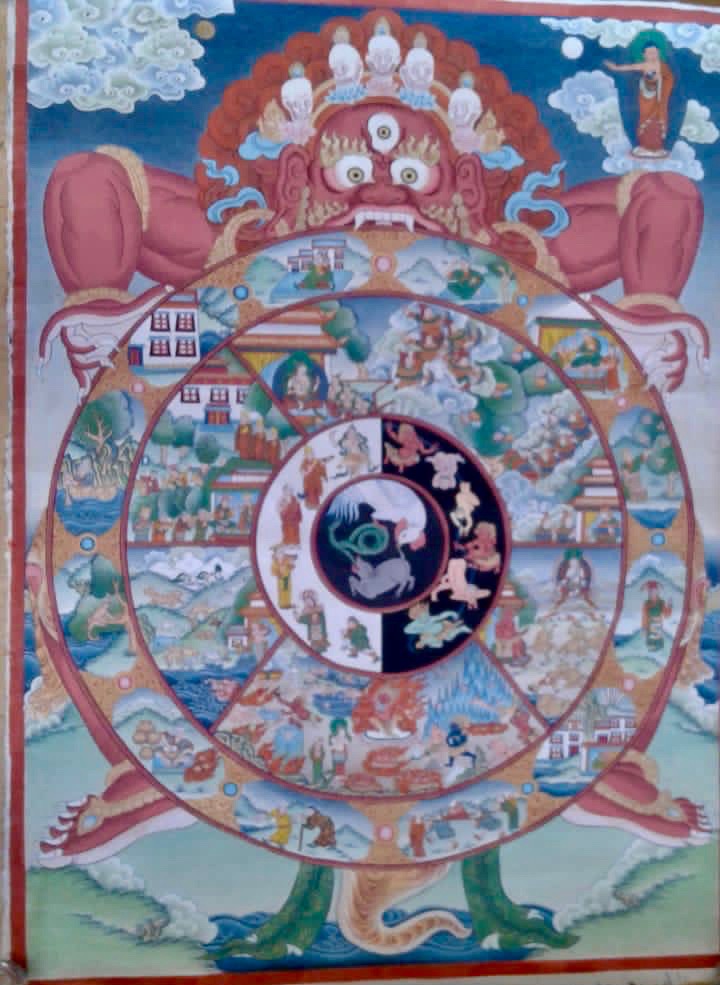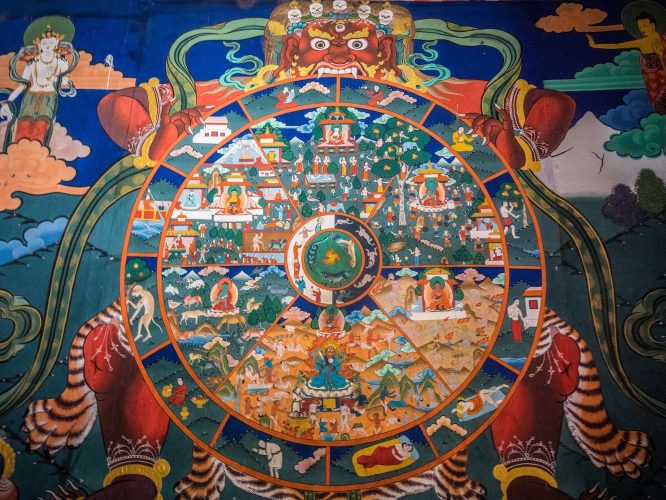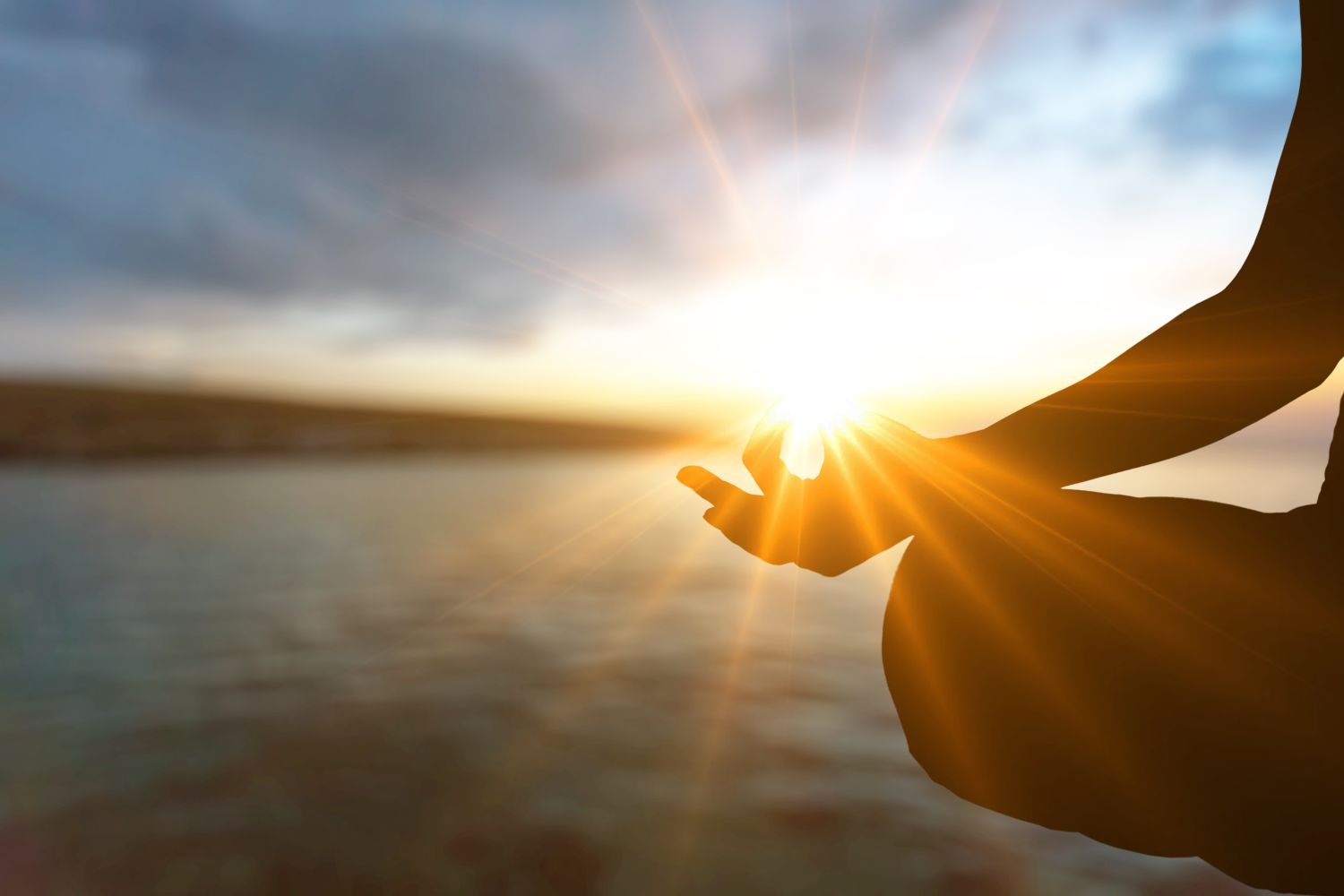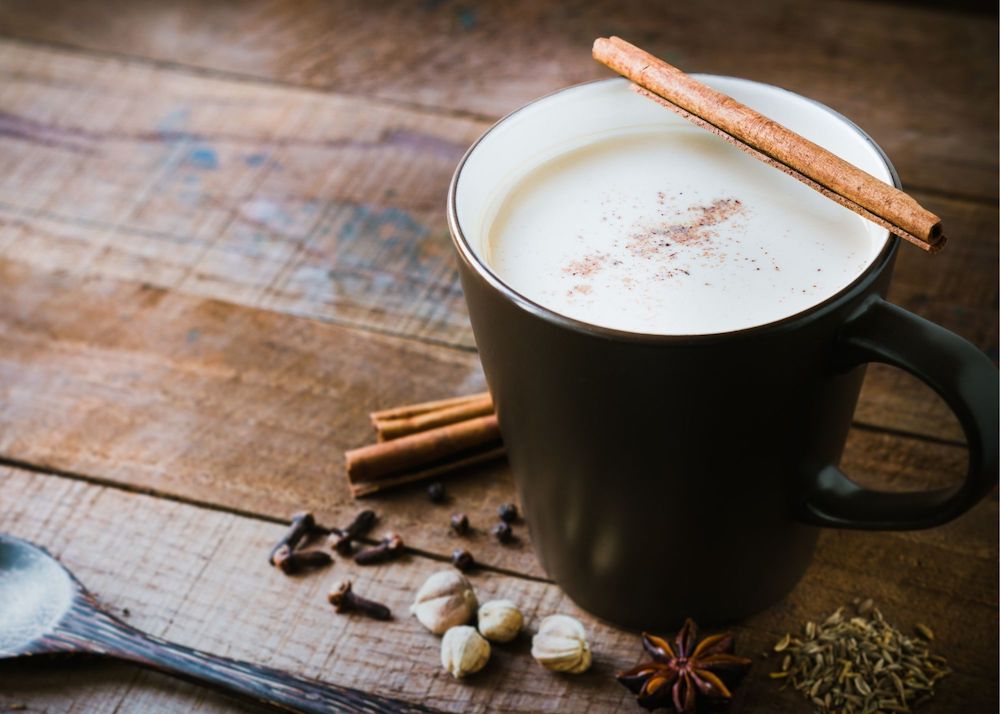The Tibetan Wheel of Life addresses the meaning of life. It explains the causes behind the pain and sufferings of all existence and, therefore, shows us a path out of it. In Tibet and among Tibetan communities in exile, this painting is often found at the doorways of temples. It is a painting of a wheel 21 parts that outlines the process of rebirth.

A Brief Overview
At its core, it consists of four circles. The outermost circle represents the 12 links of dependent originations – the chain of causes linked to each other and responsible for our never-ending cyclic world of suffering. I believe that to study this is to delve into the very heart of the Buddhist philosophy of cause and effect. This is a huge topic, outside of the scope of this essay, but for those who want to learn more, His Holiness the Dalai Lama wrote an entire book on this topic, titled The Meaning of Life: Buddhist Perspectives on Cause and Effect. The innermost hub depicts a pig, a rooster, and a snake. They represent the three poisons of our afflictive emotions: ignorance, anger, and desire – the source of all our sufferings in the first place. The light and dark half-circle just outside this inner circle depicts virtuous and non-virtuous actions that stem from the three poisons. The wheel is in the grasp of a frightful monster, signifying that the entire cyclic existence is impermanent.
The Circle of Our Focus
I want to quickly explain that this article is not an explanation of the Wheel of Life. Aside from the brief introduction above, for the most part, I’m going to focus on my own interpretation of what we can learn from it. Every aspect of this painting is illuminating and fascinating, but I’m going to focus and write about the second circle from the outside, because I’ve always felt that this is where the real lesson from the Tibetan Wheel of Life rests.
The Second Circle
This circle depicts the six realms of transmigration, and it is this circle that we will explore together for inspiration and learning. The six realms in this circle can be divided into two main segments – the higher realm and the lower realm. On the Wheel of Life diagram, the three higher realms are depicted on top and the lower realms at the bottom. Right on top of the higher realms is the realm of the devas, or God-like beings. This is a place of abundance – the gods have everything – material riches, beautiful dwellings, and long lives. But it is not a perfect realm, because a prolonged life of ease, comfort, and riches lead to moral and spiritual decay. It is more than likely that the dwellers in this realm may ultimately take birth in some of the other lower realms.
To the right of the God realm is the realm of the asuras, or the demigods. These are dwellers who are close to but not really gods. They perceive their world to be imperfect, their lives being fueled by an overwhelming sense of envy and jealousy of the Gods above them. These strong emotions often generate and even propel other feelings of anger and violence. It stands to reason that although the demigods enjoy privileges above mere humans, their realm is far from perfect.
Still on the higher realms, to the left of the God realm is where we are as human beings. This is the realm that excites me the most, and we are going to revisit this just as soon as I’ve briefly introduced the three lower realms.
Believe me, we do not want to be in the three lower realms. For many lay Tibetans, one of the reasons for our diligence with prayers, earning merits, and making pilgrimages are so that we do not end up in any of these three lower realms. Briefly, the lower realms are those of animals, hungry ghosts, and hell. The realm of animals is characterized by ignorance, never-ending cravings characterize that of the hungry ghosts, and hell’s realm is one of extreme suffering. If these three realms sound horrible, they are – not only because you can sense grief and unpleasantness but also because there is little opportunity for spiritual growth, to expand the consciousness, and to find a path forward to liberate oneself from the torment of cyclical existence.
Viewed from this lens of liberation and finding a path out of cyclic existence, our realm – the human realm – presents the most potential. That is why, in the Tibetan Buddhist world, we consider ourselves to be the most fortunate, and we talk of having this precious human life we call jordhen milu.
The Blind Turtle Analogy
With a global population of seven billion, we may not think so, but many Tibetans believe that it is not easy to acquire and be born in this human realm. The following analogy may seem a bit far-fetched or even exaggerated, but being born as an intelligent human being with access to learning the Dharma has been compared to the proverbial turtle in the ocean. Imagine a blind turtle floating in a vast ocean. Imagine a wooden yoke or something we see more often nowadays, say a tire, floating in that ocean. Every once in a while, the turtle will pop its head out of water. What are the chances that the turtle will thread the needle and pop its head out of that floating tire? That is the kind of slim chances we give ourselves of genuinely having a precious human body, equipped with intelligence, provided with the circumstances of having the resources and the access to learn about the precious teachings.
In our own Tibetan circles, I’ve known people who cast aspersions on this blind turtle analogy – there are just too many human beings to give credence. Come on, you mean to say this turtle has threaded the needle 7 billion times? He must be getting good at it by now! But I’ve also met Tibetans who will stand by their turtle and point out the zillions of lives that exist on our planet. Lift a rock, and you’ll see thousands of ants under it, they argue. Or take a peek into the ocean and look at all the incredible life there. You can see where this argument is going.
Be that as it may, there is no debate that our intelligence as human beings, our ability to discern and know good from evil, separates us from the animal world. It is equally vital that we are mindful of this intelligence and use it to learn and to benefit all sentient beings. If we don’t, we may not be far removed from the being in the animal realm. In the realm of hell, the overwhelming sufferings of heat and cold make it impossible to think of anything else aside from the nightmare. Similarly, in the hungry ghosts’ realm, one’s whole life centers around craving because they are constantly hungry or thirsty or in some other want. When you are in a state of perpetual desire, there is no space for other things, certainly no room for learning and spiritual growth. Unless there is a substantial karmic intervention, being in the lower realms seriously limits a path forward. Once again, the lesson from the Wheel of Life is that our human life is precious. We owe it to ourselves and to all our karmic actions that got us here in the first place to make the very best of this precious life.
Layers of Meaning
Several years ago, I had the immense good fortune to travel with and learn from one of the greatest Tibetan sand mandala creators of our time: the venerable Ngawang Chojor. We did more than a dozen events with this wonderful artist – most of them in places like Montana, North Dakota, and Wyoming, where folks don’t get a lot of Tibetan culture. From him, I learned that the Tibetan sand mandala has many layers of meaning. At the outer layer, the mandala represents a Buddha’s world. It is a two-dimensional sand representation of a three-dimensional Buddha’s realm or palace. But, at a deeper level, it could also represent the map of an enlightened brain, and from that perspective, it can be a guide to meditation. He smiled and brushed me aside when I tried to probe the innermost meaning because, as a layperson, it was partly esoteric, and he wouldn’t even share it with me!
Symbolic Meanings of the Different Realms
In much the same way, I understand that the meanings and explanations of the six realms of existence in the Wheel of Life can also have layers of meanings. The different realms can be symbolic representations of various human forms and conditions. The billionaire class with their wealth and privileges could represent the God realm; many (not all) are so engrossed in their life of luxury that they have no time or apparent need for spiritual growth. The realm of the demigods (asuras) can represent jealous and wealthy people in power who want to climb up to that billionaire class. I smile and think that ambitious and unscrupulous politicians easily come to mind. People with low intelligence or those with no aptitude for learning and discernment may be in the animal world of ignorance. The folks with an insatiable need for everything and anything could be roaming the realms of the hungry ghosts. Finally, maybe because of past karmic deeds, we have people who cannot devote time to spiritual and personal growth because of the immense sufferings and pains in their lives – it is like they are in their personal hells.
Jordhen Milu – This Precious Human Life
Even from this allegorical lens, the most fortunate are the people who have the intelligence, resources, good health, and space in their lives for growth and spiritual practice. Maybe this group of people truly represent the most precious of all human lives; maybe it is this group that represents the turtle who threaded the tire in that vast ocean. I think it is this group that the Tibetans call jordhen milu.
So for me, a powerful lesson from the Wheel of Life is the realization of how precious our human lives are. Realizing this can help us become the best that we can, to lead good and meaningful lives. I’m motivated to share these thoughts from our spiritual heritage because I believe they have the potential to truly change lives. Mind you, it is not easy. It takes some effort, some amount of daily mindfulness, but I believe real change is possible. H.H. the Dalai Lama explains there are “three levels of understanding” for inner transformation to take place. The first level is when you read or hear about something. The second is when you reflect on it deeply, see truth in it, and feel a sense of conviction. Finally, through daily mindfulness, we cultivate a sense of familiarity with the fact, internalize it, and make it a part of our nature. I hope each of you will reflect deeply on your own lives and realize with conviction how precious our human lives are, and how we owe it to ourselves, and to everyone else, to become the best we can.
It is important to be mindful of this lesson every day. H.H. the Dalai Lama has touched millions of lives with his wisdom. This is what he encourages:
“Every day, think as you wake up, today I am fortunate to be alive, I have a precious human life, I am not going to waste it. I am going to use all my energies to develop myself, to expand my heart out to others; to achieve enlightenment for the benefit of all beings. I am going to have kind thoughts towards others, I am not going to get angry or think badly about others. I am going to benefit others as much as I can.”















One reply on “An Important Lesson from the Tibetan Wheel of Life”
Wonderfully descriptive and easily understandable. Will take every word with me as I continue on.
Thank you for all you do for our human race.